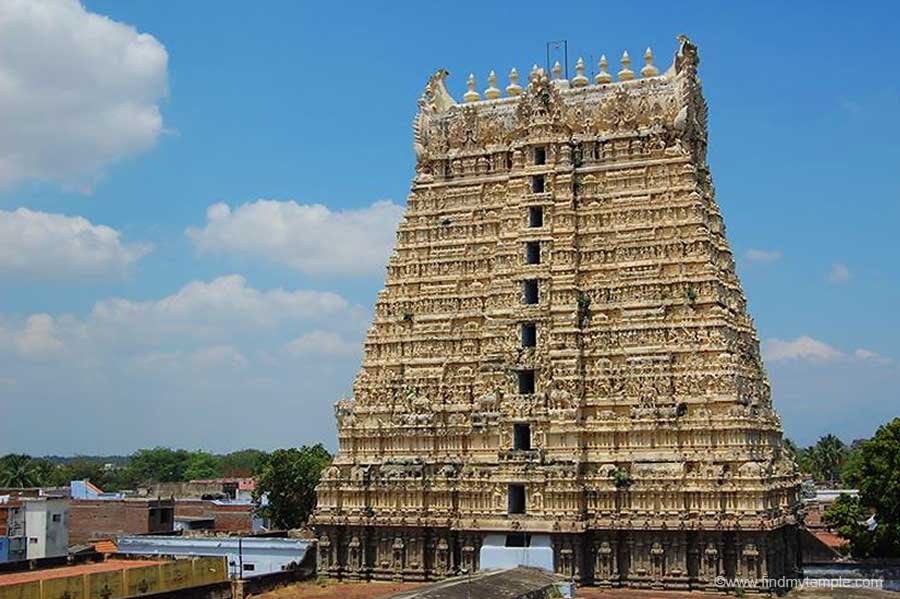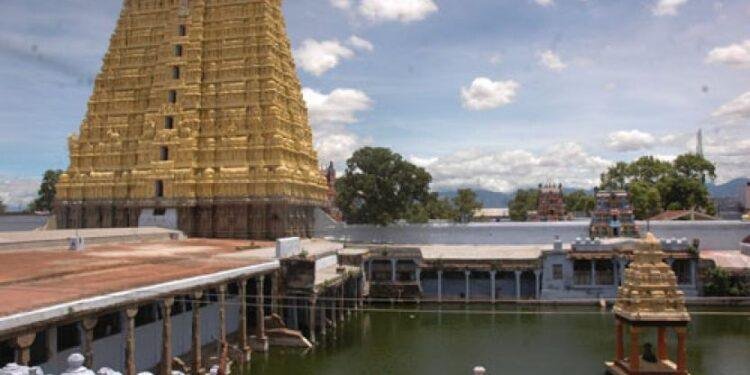One time Goddess Umadevi requested Lord Siva to remove the difference among the devotees, who is the powerful god, whether Lord Siva or Hari. Then the lord Siva appeared as Sankaranarayanar.
Shrine’s History
Serpent King Naga was a staunch Shiva devotee. Paduman, also a serpent, was a staunch Vishnu devotee. Both were frequently debating about the supremacy of their respective Lords. They went to Mother Parvathi for a verdict. Ambica took to penance praying to both Lords to grant a joint darshan to establish the truth that both were only equal. Responding to Mothers penance, both granted darshan jointly as Sankara Narayana. Shiva also granted a darshan to Mother Parvathi as Sankaralingam. In the days that followed, this Linga was covered by an anthill. The two serpents also were in. A devotee while demolishing the anthill, cut the tail of one serpent which began to bleed. The incident was immediately communicated to the Pandya king. He immediately built this temple.
Lord Sankaranarayana shrine is in between the shrines of Lord Shiva and Mother Gomathi. The right side of the deity belonging to Lord Shiva has Agni the fire, Ganga, crescent moon and the turf, earring, Rudraksha on the chest, Mazhu the weapon of Lord Shiva and tiger skin clothing in the waist. Sangan is holding the umbrella in the Tiruvasi ? the frame around the Lord. On the left, belonging to Lord Vishnu appears with His gem studded crown, a hanging earring-Kundalam-tulsi bead and Lakshmi mala in the chest, a conch and the silk-peethambara around the waist. Paduma is holding the umbrella in this side. Tulsi theertha is offered as Prasad during morning pujas. Vibuti the sacred ash is offered during other pujas. Garlands of Tulsi and flowers are offered during the pujas. Vilwa for Shiva and Tulsi for Vishnu are used in pujas. Lord Shiva is fond of Abishek-bathing while Lord Vishnu is fond of attractive dressing. Lord Sankaranaraya always appears in His best Alankara-dressing.
Abishek in the shrine is offered to Lord Chandramouleeswara the Spatika Linga-crystal Linga. Pujas are offered to Him on Shivrathri and new moon days. He comes off the shrine to grant darshan to Ambica on Aadi Thapasu festival day. Gomathi: Go means cow and Mathi Moon in Sanskrit. Maidens from the celestial world came along with Ambica in the form of cows to help Her penance. With a face as radiant as the Moon and being the owner of cows, Ambica is called Gomathi. She is also praised as Aavudayambikai being the Tamil version of Gomathi. Mother is dressed with flowers on Mondays and golden skirt on Fridays.
Those facing problems in wedding efforts and concern about childrens welfare pray to Mother Gomathi lighting lamps made of rice flour mixed with ghee. Sri Chakra, personifying the glory and power of Shakti is installed either under the peeta bearing Ambica or in front of the peeta. Here, Sri Chakra is installed in the Mandap before Ambica. This is called Agna Chakra. Those with depression and confusion sit on this Chakra and pray to Ambica. They believe they would be freed from confusions.



Shrine’s Map Location and How to Go There
By Road
The nearest Bus stop is Sankarankovil.
By Rail
The nearest Railway station is Sankarankovil.
By Air
The nearest Airport is Tuticorin Airport.

Shrine Timings
Morning – 5.30 am to Afternoon – 12.15 pm, Evening – 4.00 pm to Night – 9.30 pm
Events Celebrated at This Shrine
Aadi Thapasu in July-August; 41-day Brahmmotsavam in Panguni-Chithirai covering March to May; Aipasi wedding festival in October-November and Thai float festival in January-February are the festivals celebrated in the temple.













































